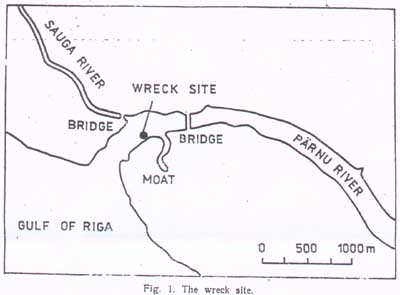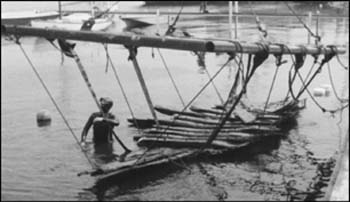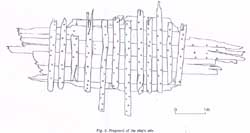| In May 1990 a wreck of an unknown ship was discovered in the course of the dredging of the left
bank of the Pärnu River by a newly built pier of the yacht club. The wreck lay embedded under a
30-40 cm layer of mud at the depth of 1.5 m of water. Before dredging was stopped temporarily, a
certain amount of fragments of the ship's planks and ribs were taken ashore by an excavator. On May 24, 1990, a preliminary inspection of the wreck site was carried out by the researchers of the Estonian Maritime Museum. Having seen that the ship's wood was black oak, the researchers decided that the find would need most serious attention and detailed investigation, so the digging of the river bottom could not be continued. In July a thoroughgoing research of the wreck was made. The site of the object was explored by means of iron rods and the measurements of the find were ascertained.
The wreck site. In August some of the mud covering the wreck was removed by means of a water-dredge to make it possible to fix the state of the compactness of the find. A narrow longitudinal trench was dug across the wreck in east-west direction. The river mud was found to be fine-grained and easy to remove. The total area of the compact part of the wreck, a probable fragment of the ship's side, was determined to be 8.5 m X 3.5 m at the maximum. Fragments of Dutch clay pipes, various iron nails, and pieces of medieval Rhine pottery were found in the course of dredging. A sample of wood from one of the ship's planks, analysed in the Laboratory of the Institute of Geology, showed the wreck to date with the probability of 95.4% from 1285 to 1398 AD, the age of the wood correspondingly 615 +/- 35 BP. The result of this analysis (Tln-1473) has been corrected applying the method of Stuiver & Pearson, 1986. A complementary 14C analysis of the wood of the ship's frame was made at the Institute of Zoology and Botany of the Estonian Academy of Sciences in Tartu. This analysis (TA-2282) dated the wood to the period from 1250 to 1330 AD, with an age of 600 +/- 40 BP. As an indirect evidence of the ship's age some fragments of Rhine pottery, found on the wreck, could be taken into consideration. Two pieces of a small earthen jug, a fragment of its neck and a part of the handle damaged by fire, were dated to the 14th century. Although there is possibly no direct connection between the pottery and the wreck, one should bear in mind that the wreck lay underneath the pieces of pottery and therefore could not be substantially younger.
Lifting the fragment. Photo by Tõnu Sepp. In conclusion it was considered that the ship could be dated to the turn of the 13th and 14th centuries, being thus the oldest wreck ever found in the waters of Estonia. The excavation of the wreck had primarily been planned to be done by the Estonian Maritime Museum in May 1991. For some technical reasons the Museum's research vessel Mare was not in working order by that time and the authorities of the town of Pärnu, suggested that excavation should be done by the diver's club Süvala from Saaremaa. In June 1991 the wreck was excavated extremely rapidly without any previous preparation. This affected on the quality of the excavation from the point of view of the further investigation of the find. Thus, the number of artefacts, most necessary for more precise dating of the ship and expected to be discovered in the course of the excavation, turned out to be very small. The research carried out by the Maritime Museum determined that the fragment of the wreck (maximum measurements 7.90 m in length and 3.75 m in width) belonged to the ship's side. The manner of building of the ship is quite robust. The planks were made by splitting oak trunks tangentially. The type of the ship's planking is clinker. The overlapping edges of the planks are joined by means of twice-bent iron nails. The wreck has outer planking only. The ceiling planking is missing. Fragment of the ship's side The edges of the clinker planks have an acute angle profile to facilitate caulking. The caulking material has been determined to be moss (Sphagnum sp.). The plank seam filled up with moss is covered with wooden laths, secured to the planks by means of iron clamps. The iron nails by means of which the edges of the clinker planks were fastened together, have mostly rusted away. Only the heads of the nails, consisting of iron oxide, can be seen on the surface of the planks. On the inner side of the heads very specific pins can be seen. Scarfs have been used for longitudinal connecting of the ship's hull planks. According to the results of the 14C analysis the Pärnu ship could be determined to be one of the types of vessels that prevailed on the Baltic Sea, in the 13th and 14th centuries. The strong construction of the wreck points to a sea-going ship. It is generally known that among the prehistoric and medieval types of vessels the clinker-built Scandinavian ship (the Viking ship) and the Hanseatic trader were prevailing on the Baltic Sea. In the case of the Pärnu shipfind, the Viking-type ship is out of the question, because of the elements of the building technique described above: the thickness of its planking, the manner of securing the planking to the frames, the method of joining the overlapping edges of the planks to each other, and the technology of caulking. Therefore all attention should be concentrated on a medieval cargo vessel, the ship that served as the main carrier of the Hanseatic trade and has generally been known as a cog. To answer the question whether the Pärnu ship could be classified as a cog, it is necessary to have an exact idea of this type of ship. In spite of a number of medieval vessels, mostly found in the course of the reclamation of the former Zuiderzee and creating the ljsselmeerpolder, there is not much information about cog-type ships. By now the only wreck of this type, the Bremen cog, has almost entirely been restored. Investigation and documentation of this ship has given us an opportunity of formulating the positions for the classification of this important North-European trader of the Middle Ages. There is a set of features, which one must keep in mind when classifying a cog-type vessel, as specified below:
At the Pärnu ship only five technical features of the shipbuilding technology could be compared with these criteria. No less than six more important features remain uncompared as the greater part of the ship seems to be still resting on the bottom of the river. Thus, the definition of the Pärnu shipfind has yet to stand as a hypothesis. Future investigations might show whether it is the wreck of a cog or some other type of medieval cargo carrier. As the oldest wreck ever found in Estonia and most likely the remains of a probable cog, the Pärnu ship is undoubtedly an object of great interest. A particular coincidence of the original iron nails from the Pärnu wreck with those from the Kollerup cog (a 13th century ship found in north-western Denmark) permits us to have new insights into the trade of the medieval sea or of Pärnu. Further investigation of the site of wreckage would probably give some new data. Most likely the possibilities offered by marine archaeology in the waters of the Pärnu River are not yet exhausted. by Vello Mäss
|



 Back to Nordic Underwater Archaeology
Back to Nordic Underwater Archaeology